Parker concentrated on his skewered marshmallow, turning it over and over at the edge of our campfire. Slowly, tediously, my 10-year-old son rotated the white, mushy ball, which soon took on an amber tone from the heat. The amber deepened to a golden brown. Then, just as the marshmallow threatened to sag into the flames, he pulled it away from the fire. Instead, the brown, sweet glob dropped onto a slab of chocolate, which he quickly squished between two graham crackers.
“It’s a perfect one!” smiled Parker, trying to get his mouth around his S’more.
“It won’t fit,” chuckled Carolyn, my friend’s daughter, watching Parker’s progress while forgetting about her own marshmallow.
“Better pay attention,” admonished Cindy, Carolyn’s mother. Carolyn’s eyes widened as she held up her stick. The blazing marshmallow at its tip lit up the darkening evening. She blew out her tiny torch, then blew on it again to cool it slightly before shoving it unceremoniously into her mouth in one huge bite.
“That’s how snakes eat!” chided Parker. “They open their mouths super wide, then swallow their food whole. You’re a snake, Carolyn.”
“Then you are, too!” replied Carolyn, returning the taunt.
“No, I’m not,” said Parker. “I’m a river rat.”
At that, Cindy and I doubled over with laughter. A river rat indeed! It was day one of our three-day family canoe-camping trip. The grown-ups were seasoned paddlers, but it was the first river trip for the kids. In the past, our two families had taken annual backpacking trips together to introduce our children to the outdoors. This year, we decided on a canoe-camping trip for several reasons.
Our kids were at an age when they were still too small to carry a heavy pack, yet their stuff was getting bulky enough (and the adults old enough) that the effort to lug such sizeable loads into the mountains had become less appealing. On a canoe-camping trip, if we chose a river without impoundments or rapids to portage around, not only would we have nothing to carry but we could also bring a few creature comforts – such as the ingredients for S’mores. Plus we could go swimming and fishing and hopefully see some interesting wildlife.
We chose a section of the Northern Forest Canoe Trail in northern New Hampshire for our river trip. This 740-mile water trail begins in Old Forge, New York, then winds east and north through Vermont and New Hampshire, eventually terminating at the Canadian border in Fort Kent, Maine. It’s a liquid trail that traverses more than 60 lakes and ponds and is connected by multiple rivers, including the Missisquoi River, a nationally recognized Wild and Scenic River.
Wild and Scenic Rivers Act
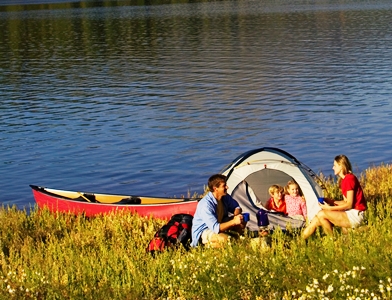 Congress created the National Wild and Scenic Rivers System in 1968 to preserve free-flowing waterways with natural, cultural, and recreational values “for the enjoyment of present and future generations.” Upon signing the Wild and Scenic Rivers Act, President Lyndon B. Johnson stated:
Congress created the National Wild and Scenic Rivers System in 1968 to preserve free-flowing waterways with natural, cultural, and recreational values “for the enjoyment of present and future generations.” Upon signing the Wild and Scenic Rivers Act, President Lyndon B. Johnson stated:
In the past 50 years, we have learned – all too slowly, I think – to prize and protect God’s precious gifts. Because we have, our own children and grandchildren will come to know and come to love the great forests and the wild rivers that we have protected and left to them…. An unspoiled river is a very rare thing in this nation today. Their flow and vitality have been harnessed by dams and too often they have been turned into open sewers by communities and by industries. It makes us all very fearful that all rivers will go this way unless somebody acts now to try to balance our river development.
The Wild and Scenic Rivers Act protects a designated stretch of water and recognizes uses of that water through a management plan. The development of the management plan is meant to be apolitical and consider public opinion. Today, 12,700 river miles across the country are designated as Wild and Scenic Rivers. It sounds significant, but it’s actually less than one percent of America’s river miles.
Each official Wild and Scenic River in the United States is administered by either a federal or state agency. A designated river is not necessarily an entire river. It might be a certain stretch of it, and it may include tributaries. For federally managed rivers, the boundary of the designation contains an average of a quarter-mile of land along both riverbanks (a half-mile on rivers outside national parks in Alaska) because riparian zones and other adjacent lands have a direct impact on the health of a waterway.
The reasons for protecting a river are many. Vibrant rivers are directly related to every American’s well-being. Rivers and streams provide two-thirds of our nation’s drinking water supply. Our history, culture, music, art, and literature have profound ties to our waterways. River-related recreation and tourism accounts for almost $100 billion in economic impact each year. For my family, our river trip allowed an affordable, outdoor vacation. And rivers provide diverse habitat supporting a plethora of wildlife, as my son discovered on our paddle trip on the Northern Forest Canoe Trail.
The Geese
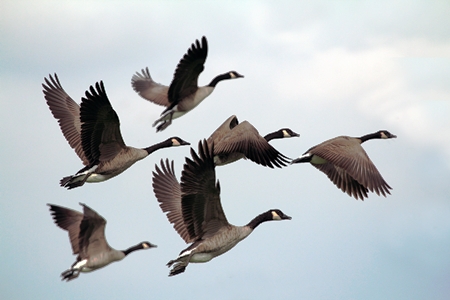 Our three-day canoe-camping trip covered only 20 miles of the Northern Forest Canoe Trail, but it proved of infinite value, introducing our kids to the pleasures of paddling and the importance of having pristine places in which to do it.
Our three-day canoe-camping trip covered only 20 miles of the Northern Forest Canoe Trail, but it proved of infinite value, introducing our kids to the pleasures of paddling and the importance of having pristine places in which to do it.
We launched our small flotilla of two canoes and three kayaks just after sunrise. Although the day promised to be fair, an eerie mist curled off the river around us, adding a touch of mystery to the start of our adventure. The two pairs of parents manned the fully-laden canoes. The kids – Parker, Carolyn, and Carolyn’s brother Ron – were in the kayaks.
The fog muted the morning’s sounds, making me acutely aware of each swish of my paddle. The parents pulled hard to keep up with the kids, who seemed to glide effortlessly downstream in the gentle current. I quickly forgot our chilly cast-off as drops of perspiration tickled my back under my life jacket.
Rounding a river bend, I noticed Parker’s boat grounded on an elongated sandbar just below a low hump of grass. He was sneaking up on something on the other side of the hump. At the same time, Ron had ceased to paddle his kayak and appeared to be stalking something by water. Suddenly, a gaggle of Canada geese burst from the sandbar and dispersed raucously, some taking flight and others splashing into the river. It would be the first of several memorable wildlife encounters on our trip.
The Mice
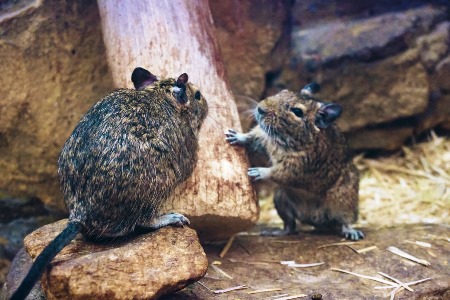 The second wildlife encounter happened shortly after we finished the S’mores at our first campsite. We had pitched our tents at a designated spot about six miles from the put-in, on a low plateau above the river. As we finished the sweet treats, I pointed to a wooden box at the edge of the clearing.
The second wildlife encounter happened shortly after we finished the S’mores at our first campsite. We had pitched our tents at a designated spot about six miles from the put-in, on a low plateau above the river. As we finished the sweet treats, I pointed to a wooden box at the edge of the clearing.
“Parker, would you do the honors and sign us in?” I asked.
All campsites along the Northern Forest Canoe Trail have a register that paddlers are supposed to sign. If there’s an emergency or if someone is missing, it helps searchers figure out where they might be. In addition, it helps monitor the use of the water trail.
Parker strode casually over to the sign-in box and lifted the top.
“Mom!” he shouted, a touch of panic mixed with the excitement over his discovery. He quickly let the lid drop back into place.
“What’s in there?” I asked, lifting the top of the box and peering inside. I expected to see a large snake. Instead, I found a half-dozen newborn field mice cuddled with their mother. The camping register was an indiscernible jumble of shredded paper, providing a cozy nest for the mice.
“Don’t let them out!” said my son, urgently closing the box again.
“I don’t think they want to come out,” I said. “They’re too small. Let’s leave them alone.”
We returned to the campfire, which had mellowed to glowing embers. After the kids used the bailing buckets from the canoes to douse the remains of the fire, everyone retired to their tents.
About an hour later, I heard a twig snap.
“Shhh!”
Giggle.
The kids were up to something. I cracked my tent flap to see the three of them tiptoeing toward the sign-in box. Parker lifted the lid and chanced his flashlight beam, proudly showing the mice to the others. I nestled back into my sleeping bag, glad for their curiosity over the field mice.
The Fish
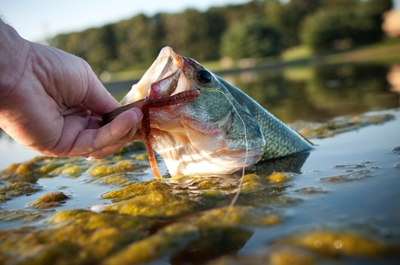 The next day, we pushed off into another heavy mist. Like the day before, it quickly dissipated as the sun climbed higher in the sky. By mid-morning, everyone had stripped down to swimsuits under their life jackets.
The next day, we pushed off into another heavy mist. Like the day before, it quickly dissipated as the sun climbed higher in the sky. By mid-morning, everyone had stripped down to swimsuits under their life jackets.
A natural, sandy beach formed at the bend of each oxbow of the river, enticing us to take a dip, which we did, over and over. As a result, the miles melted slowly by, but we were not in a rush. In addition to spending time together on an outdoor adventure, a family canoe trip means time to relax, unplugging from civilization for a while, and casting a line at one’s leisure. From the moment we put-in each morning, if we weren’t actively fishing, we were trolling as we paddled.
“Mom, I think you’ve got one!” shouted Parker from his kayak as my rod bumped a few times behind me in my boat. I turned, grabbing my rod just as it threatened to bounce into the water. I let the fish run, then, feeling it pause and turn, I reeled in quickly to keep slack from the line.
“Could be dinner!” I shouted back to Parker, but he didn’t hear me. He had hooked one, too.
“I got one!” he exclaimed, holding his reel in the air while trying to stow his kayak paddle. The task was impossible for a ten-year-old, who had limited experience in such a tippy watercraft. As his reel bent, he dropped his paddle into the water, needing both hands to control his fishing rod. The feisty fish began to pull the kayak to starboard.
I brought my fish to net, a nice two-pound smallmouth bass, then my husband and I paddled over to Parker.
“I’m waterskiing!” he giggled as the fish and the current continued to move him toward the right riverbank. As we got closer, the fish jumped. Another bass. Parker took advantage of the break in the tension and reeled in enough to keep the fish in sight just below the waterline.
“Strong fish,” I thought. But it wasn’t stronger than two adults in a canoe. My husband maneuvered us close to our son, then grasped the back of his kayak to steady it. From the bow of our boat, I was close enough to get a net under the fish and scoop it up.
It was a beauty! Fifty percent bigger than mine. That evening, we cooked both of our catches over our campfire. Parker served up pieces of fish to everyone with such pride. There is something basic, even primitive, about catching one’s own food that subliminally causes a person to embrace the circumstances in which the food was obtained. In Parker’s case, it gave him a new level of self-confidence in what would be a growing love of the outdoors, particularly paddle trips. It also planted a seed of stewardship.
National Water Trails
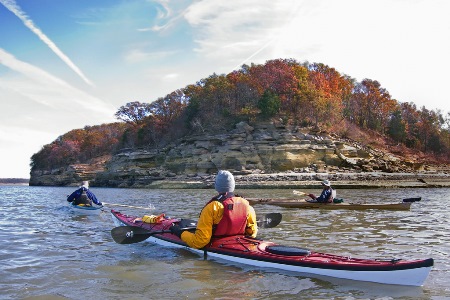 It is Parker’s generation’s sense of stewardship that will ultimately determine whether our water trails remain intact and clean enough to support not only our recreational whims but also our general water needs. It’s often a recreational experience – such as our family canoe-camping trip – that highlights for today’s youth the importance of clean water and where it comes from. The outing does not have to be on a river designated as “wild and scenic.” There are other water trails throughout the United States where families can paddle together. Some of those waterways have the designation of National Water Trail.
It is Parker’s generation’s sense of stewardship that will ultimately determine whether our water trails remain intact and clean enough to support not only our recreational whims but also our general water needs. It’s often a recreational experience – such as our family canoe-camping trip – that highlights for today’s youth the importance of clean water and where it comes from. The outing does not have to be on a river designated as “wild and scenic.” There are other water trails throughout the United States where families can paddle together. Some of those waterways have the designation of National Water Trail.
The National Water Trails System, administered by the National Park Service, is a network of waterways that are available to the public to explore yet are actively managed to provide clean water for a variety of needs. According to the National Park Service, the goal of the federal water trail system is two-fold: 1) to protect and restore America’s rivers, shorelines, and waterways and conserve natural areas along waterways; and 2) to increase access to outdoor recreation on shorelines and waterways.
Like Wild and Scenic Rivers, the National Water Trails System relies on the cooperation of federal, state, local, tribal, and nonprofit entities to identify and maintain those waterways and the surrounding lands. However, the Secretary of the Interior may designate a National Water Trail (unlike a Wild and Scenic River designation, which requires an act of Congress). Another difference between a National Water Trail and a Wild and Scenic River is the type of waterway that’s eligible. Wild and Scenic Rivers are preserved in a “free-flowing condition for the enjoyment of present and future generations.” National Water Trails provide access to both urban and rural waterways for outdoor recreation, education, and conservation. Water trails are also intended to be “catalysts for restoring the health of local waterways” in nearby communities.
That night, after our delicious fish dinner, Parker knocked at my tent flap then crawled in between his dad and me.
“That was a fun day,” he said from amidst the red and green sleeping bag clouds that surrounded him. “I like canoe trips. I don’t want to go home tomorrow.”
“You must be a river rat, after all,” I replied.
As his eyelids drooped, I promised him another canoe trip for our next family vacation. And I looked forward to it as much as he did.